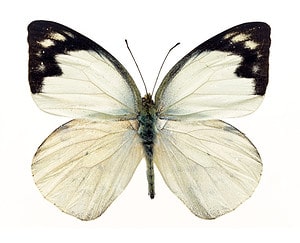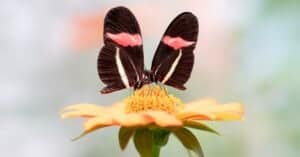Butterflies are colorful, mysterious creatures. They have a wide range of wing colors from bright yellow to midnight blue and all colors in-between. They may have stripes, spots, or wing markings that look like a pair of eyes. But one of the most intriguing things about this flying insect is the way it eats. Unlike a praying mantis or a grasshopper, butterflies don’t have teeth – also known as mandibles. So how do butterflies eat? Continue reading to learn how butterflies eat, what they eat, and why these colorful creatures love to drink muddy water.
How Do Butterflies Eat?
Butterflies take in nourishment through their proboscis. A proboscis is a thin, tube-like organ that allows a butterfly to draw liquid from a flower or plant. Think of an elephant‘s trunk or yourself drinking juice or water through a flexible straw. This is essentially what a butterfly does when it drinks using its proboscis.
When a butterfly is finished drinking, its probosci curls back up toward its face so it won’t get in the way as the butterfly moves through the air. Isn’t that convenient?
What Do Butterflies Eat?
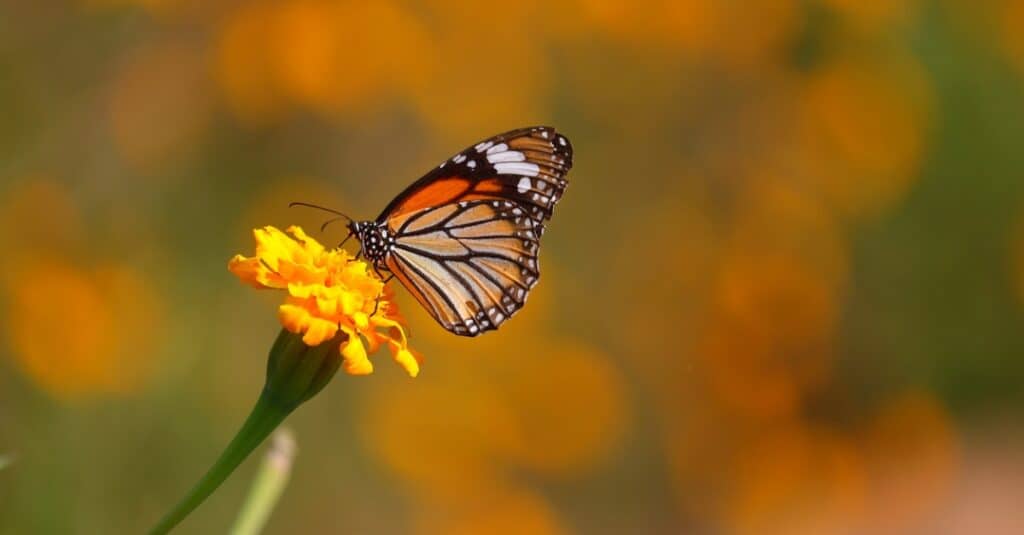
For a complete list of foods butterflies eat, check out our “
What Do Butterflies Eat?
” page.
©iStock.com/Dinesh kumar
You probably already know that butterflies eat, or are nourished by, drinking flower nectar. But’s that’s not the only food source of butterflies.
Butterflies land on pieces of rotten fruit to drink the leftover juice. Vegetable plants like zucchini, pumpkins, radishes, artichokes, and asparagus have blossoms that contain nectar. It’s not unusual to see butterflies making their way through a patch of vegetables to drink vegetable nectar. They also land on herbs with blossoms that yield nectar. Some of those herbs are parsley, oregano, fennel, and dill.
Sugar water is another favorite food of butterflies. A butterfly may frequent a feeder put out by someone who is trying to attract hummingbirds to their yard. The sugar water in a hummingbird feeder is appealing to a butterfly if it can get access to it.
You may see butterflies hanging around garbage cans at a local park, amusement park, or even a zoo. If you see some, the garbage cans probably contain cups with leftover soda or bottles with a little bit of juice or lemonade in them. These insects are attracted to sugar in practically all forms. So, if there’s a drop or two of juice or soda in a cup or bottle, a butterfly will drink it. Bees are also known to hang around trash cans for this same reason. If you see both butterflies and bees at a full trash can, you may notice that they don’t bother one another as they go about their work of finding sugary liquid.
Butterflies sometimes drink muddy water from puddles after a rainstorm. The next time it rains look around for a mud puddle in a road or on a lawn to see if there are any butterflies gathered around it. They drink the muddy water to get protein, salt, amino acids, and nitrogen. All of these muddy ingredients contribute to the overall health of a butterfly.
Sometimes, a group of butterflies will gather around a mud puddle only to take off and land again a few seconds later. There is a purpose behind this motion. The butterflies are trying to stir up the minerals in the mud by flapping their wings. This behavior is called puddling.
In addition to mud, butterflies drink sweat for its salt. So, if a butterfly lands on someone, it may be interested in a little of the sweat on the person’s arm or hand. Of course, it doesn’t hurt when a butterfly uses its proboscis to drink sweat from a person’s skin. It may tickle a little bit though.
Butterflies sometimes drink urine for the minerals contained in it. A butterfly may drink from a pool of urine left behind by an animal. They also drink blood to absorb its nutrients. Butterflies may land on a dead animal that has a wound with blood on it.
You’ll notice that butterflies are adaptable to landing on anything containing the nutrients they’re looking for.
How Often Do Butterflies Eat?
As a general rule, butterflies eat (drink) food every day. Furthermore, they drink their meals several times a day. If a butterfly is in an area where it’s difficult to find food, it can go a couple of days without it. A butterfly that cannot find food will mate with another butterfly before it dies from starvation. When they do this they are following a powerful instinct to keep the butterfly population going.
What Time of Day Do Butterflies Eat?
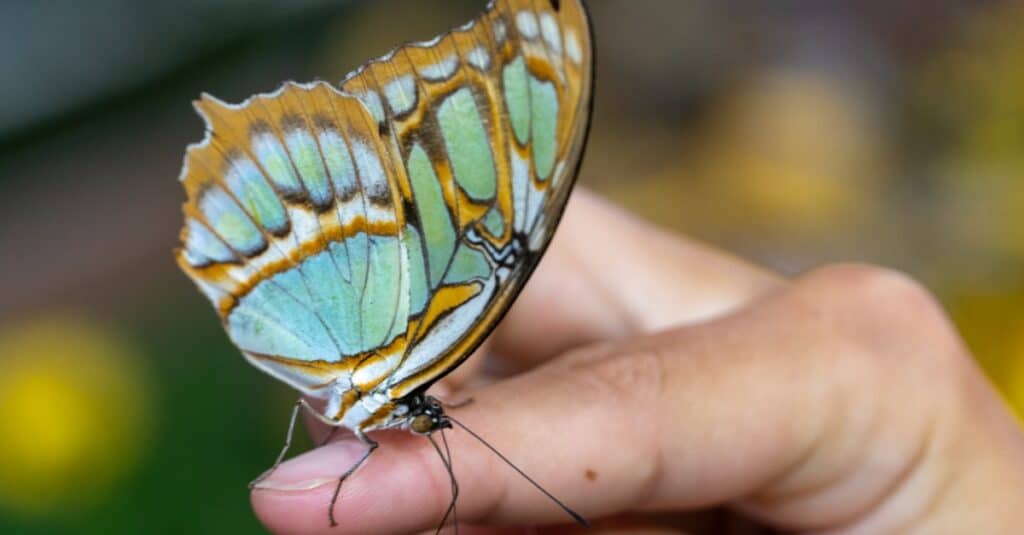
©iStock.com/Jeff Kingma
Midday is when most butterflies look for food and eat. They are especially attracted to flowers and plants growing in direct sunlight. They are cold-blooded animals and need sunlight to stay warm.
Have you ever seen a butterfly sitting on a flower or plant with its wings spread out? If so, the butterfly may have been eating. Or, it may have been basking or warming itself in the sunlight.
Are Butterflies Attracted to Different Plants?
Yes. Some plants are more attractive to some types of butterflies than others. Monarch butterflies are especially dependent on the nectar from milkweed. They also rely on this plant to lay their eggs on. The newly hatched caterpillars eat the leaves of milkweed plants. The monarch butterfly cannot survive without this wildflower.
Goldenrod, lilacs, and lantana are other plants attractive to monarch butterflies. Eastern swallowtail butterflies are attracted to phlox, buttonbush, and Carolina jessamine. Of course, some plants and flowers appeal to a variety of butterflies. Planting daffodils, wild violets, and sedum can bring a bunch of butterflies to a garden. Don’t forget to plant a Buddleia davidii aka a butterfly bush.
What Are Some Misconceptions About How a Butterfly Eats?
A misconception about the eating habits of a butterfly is that this insect uses its proboscis to taste the food to see if it’s safe to eat. In reality, after a butterfly lands, it uses its feet to taste the flower to see whether it’s sugary or bitter. Butterflies don’t have taste buds inside their proboscis. Instead, a butterfly has chemoreceptors inside its tiny feet! Think of these chemoreceptors as their taste buds. Consequently, a butterfly can tell whether a flower is poisonous or something it wants to eat. This helps to keep the butterfly alive and ensures they get the type of nourishment they need.
If butterflies can’t find the nutrients they need, they may throw up whatever fluid is in their stomach onto a patch of dirt and then drink it. This may sound disgusting to us, but it may be the only way for the butterfly to survive. If a butterfly can’t find a mud puddle to drink from to get salt, nitrogen, and other nutrients, it creates its own.
Another misconception is that all butterflies have a proboscis designed to simply suck the nectar out of a flower or plant. Though this is true for most butterflies, a butterfly with a diet of mostly rotten fruit has a proboscis with a pointed end it uses to poke through the flesh of the fruit to get to the juice. Keep in mind, its proboscis is not pointed like a sharp knife you may find in a kitchen drawer but it is sharp enough to get through a thin layer of fruit to access the juice.
There is also a lot of confusion about the carnivorous butterfly. The adult Harvester butterfly drinks fruit and flower nectar through its proboscis just like other butterflies. However, the Harvester caterpillar is carnivorous. Instead of chomping on leaves and stems like other caterpillars, the Harvester caterpillar eats insects called woolly aphids. This makes the Harvester caterpillar the only one in North America that eats meat. Once this caterpillar becomes a butterfly, it feeds on the plants infested with the same aphids.
How Can Someone Attract Butterflies to Their Yard?
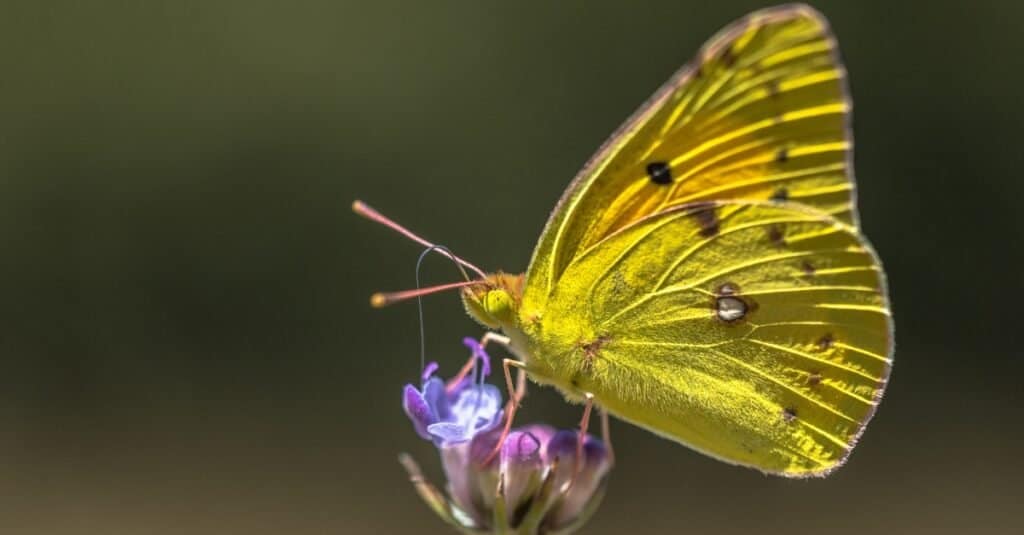
©Rudmer Zwerver/Shutterstock.com
One way to attract butterflies to a yard is to plant some of the flowers mentioned above. Many of the flowers butterflies like to visit are low-maintenance and can be planted in a location that receives full sunlight.
Slice some oranges or lemons and put them out in a dish on the patio. Butterflies are attracted to fruit juices and are likely to feel safe enough to land on the oranges you put out. Mash some rotting bananas and put them in a dish near a line of bushes in your yard. It’s best to put the dish in a place where butterflies will have easy access to it. Butterflies love this yellow, yucky mush!
Fill a dish with sugary water or even watermelon flavored juice to attract butterflies to your yard. Be sure to change the liquid and wash the bowl regularly as these warm, sugary concoctions will grow mold quickly. This can be toxic to butterflies as well as bees and hummingbirds.
Butterflies also need plain water just like birds do so adding a birdbath to your yard can help attract them. When you put out a birdbath you are helping birds, butterflies, and numerous other types of insects.
Up Next…
- 10 Types of Butterfly check out these 10 different butterfly species.
- Monarch Butterfly Most of us recognize these bright orange fliers. Check out this article to learn more about them.
- Where Do Butterflies Sleep? Have you ever wondered where and when butterflies sleep? Find out more about their sleep habits here.
The photo featured at the top of this post is © iStock.com/bwzenith
Thank you for reading! Have some feedback for us? Contact the AZ Animals editorial team.



